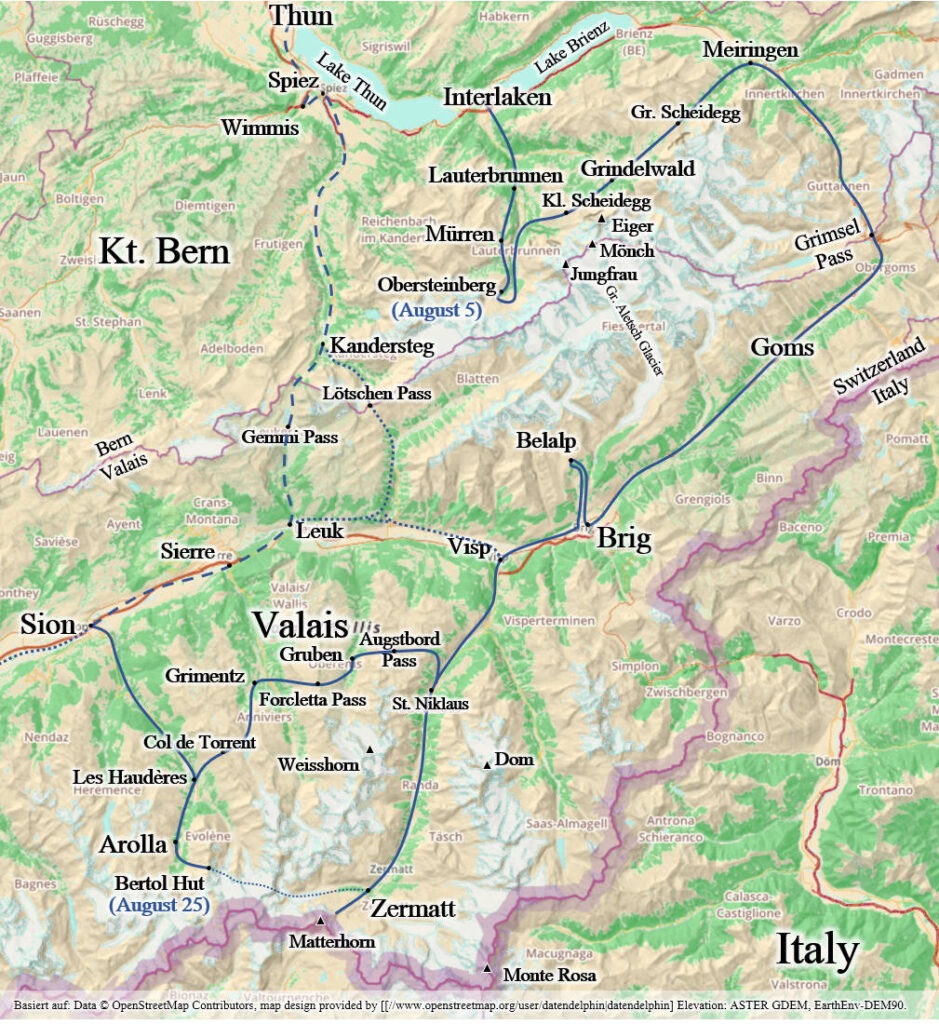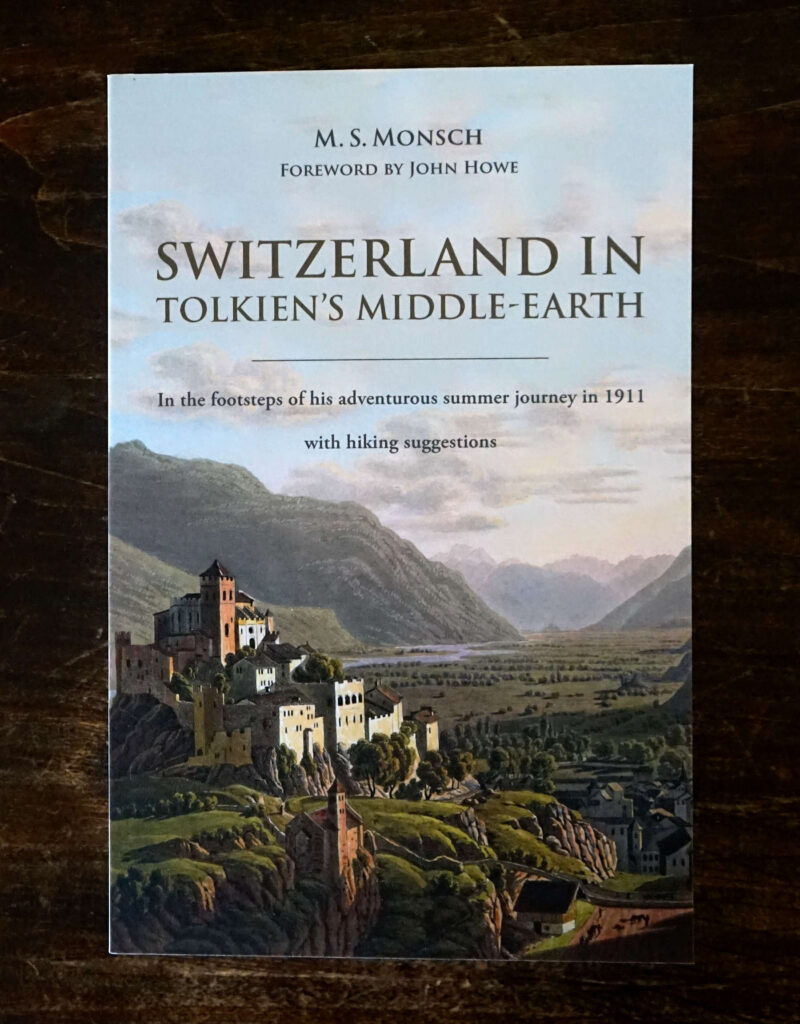Switzerland in Tolkien's
Middle-Earth
Switzerland in Tolkien's Middle-Earth
In the footsteps of his adventurous summer journey in 1911
by M. S. Monsch
Are you looking for Middle-earth in the real world? J. R. R. Tolkien’s Middle-earth was not in New Zealand, but rather in England and Switzerland. In 1911, at the age of 19, he set out on an adventurous journey through the Bernese Oberland and Valais, heavily loaded and over many high passes. And it was this hike that will later inspire him greatly for The Hobbit and The Lord of the Rings, for Tolkien was a true hobbit who hardly ever traveled.
Some of his sources of inspiration in Switzerland, Tolkien mentioned in his letters himself, but only some. So, on his tracks, I set out into the spectacular mountain world myself in search of his inspirational treasures; and little by little, I became convinced that he was not only inspired by the landscape but also by the stories, myths, and legends connected with it. Slowly, a vivid and mysterious world revealed itself to me in these mountain landscape—the world of Middle-earth.
In this book I would like to take you on this journey and treasure hunt with me; and in the appendix you will find hiking suggestions so that you can explore Middle-earth in Tolkien’s footsteps yourself. You will not regret it, I think. For me, at least, writing this book has changed the way I look at the Swiss mountains forever, and I suspect it could be the same for you.
Preface
I am […] delighted that you have made the acquaintance of Switzerland, and of the very part that I once knew best and which had the deepest effect on me. The hobbit’s (Bilbo’s) journey from Rivendell to the other side of the Misty Mountains, including the glissade down the slithering stones into the pine woods, is based on my adventures in 1911: the annus mirabilis of sunshine in which there was virtually no rain between April and the end of October, except on the eve and morning of George V’s coronation. (Adfuit Omen [that was an omen]!)
With these words, J. R. R. Tolkien began a letter to his son Michael in 1968.[1] In it, he told him in great detail about the trip to Switzerland he had undertaken as a 19-year-old in the summer of 1911 before beginning his studies in Oxford. When reading the letter, it is easy to forget that the events took place 57 years ago and that Tolkien was now 76 years old—yes, Bilbo was getting on in years, but this adventure was deeply engraved in his memory. Although his memories were no longer clear in sequence, he said, the journey had left many vivid pictures “as clear as yesterday”—“that is as clear as an old man’s remoter memories become.”
Tolkien mentioned in this and another letter from 1961[2] specific places and events that had served as sources of inspiration for his novels. Thus, he himself linked places in Middle-earth with concrete locations in Switzerland. He also mentioned that the size of the travel party corresponded roughly to that in The Hobbit, and he even described one member of the group as “one of the hobbits.” But there is a limited amount of information we can draw from Tolkien’s letters, and so he left us a riddle: was this journey merely a vague source of inspiration for Bilbo’s crossing of the Misty Mountains, or did Tolkien, over large parts, autobiographically describe his own journey through Switzerland in both The Hobbit and The Lord of the Rings?
The first step to solving this riddle is to reconstruct Tolkien’s exact journey. For this, Tolkien’s travel companion at the time, Colin Brookes-Smith, also gave us some information in his unpublished memoirs.[3] The trip probably began at the end of July and lasted at least until the end of August, but perhaps into September. Tolkien’s last school day was July 26; after that, he must have left pretty soon—maybe head over heels like in The Hobbit.[4] For two dates of the journey are known: on Saturday, August 5, Tolkien signed the guestbook in the Obersteinberg mountain inn in the rearmost Lauterbrunnen Valley, and on Friday, August 25, he put his name in the guestbook of the Bertol Hut near Arolla.[5] But these were neither the beginning nor the end of the journey: assuming that the group traveled on weekends, they probably spent at least the time between July 29/30 and September 2/3 in Switzerland; but a later return would also be conceivable.[6]
Regarding the route, I believe that Tolkien chose the way shown in Figure 1.[7] The first part of the journey to the Aletsch Glacier and the detour to Zermatt are based on his own remarks, the second part to Sion on those of Colin Brookes-Smith, and the reasoning for a possible third part back to Lake Thun I will discuss later. Surprisingly, there is little overlap between the travel accounts of Tolkien and Brookes-Smith, but Tolkien mentioned that his memories of the trip through the Valais were less clear, and his presence at the Obersteinberg mountain inn and the Bertol Hut near Arolla is now documented. However, whether Tolkien was indeed in Zermatt is not entirely certain since the route depicted by Brookes-Smith does not lead to Zermatt and Tolkien’s recollections of it may refer to Arolla.
Looking at this route, one thing seems clear: at least five weeks were necessary. The distance from Interlaken to Sion alone was over 150 miles (250 km), and according to Tolkien, the group covered this distance mainly on foot and with heavy packs.[8] The additional tours the group undertook from the various places where they stayed longer, such as Belalp and Arolla, are not even yet included. And many more miles they had to cover if they, as I suspect, returned to Lake Thun at the end of the trip. But regardless of this, it was a forced march.

1 Tolkien’s (presumed) route through Switzerland; the solid line is based on Tolkien and Colin Brookes-Smith’s comments.
EEquipped with this map, I myself set out on a journey in Tolkien’s footsteps through the Bernese Oberland and the Valais in search of his sources of inspiration. It was a journey through some of the most spectacular parts of the Alps, and it also became quite a treasure hunt—for Tolkien’s treasures of inspiration. Not unlike Bilbo, Tolkien seems to have found something precious in these mountains, something that was to take hold of him for the rest of his life. And it appears to have taken hold of me, too. So please be warned: not everyone can resist the visual temptations of the wonderful landscape.
In addition to the landscape, I was on the lookout for local tales, legends, and literary works by other famous travelers. Since Tolkien was a language professor specializing in mythology, I suspected that he might have been inspired not only by the geography but also by the stories connected with the landscape. And this treasure trove soon proved to be also more fruitful than I had expected—or even hoped for.
These links to Switzerland should not give the impression that Middle-earth is based entirely on that country: Tolkien was inspired by a wealth of sources, including his native England, Germanic-Norse and Celtic legends, the history of the decline of the Roman Empire, and the novels of William Morris and George MacDonald, to name but a few. Nevertheless, I became convinced that the influence of the Swiss journey was immense, not only for the geography of Middle-earth and the plot in The Hobbit but also for the plot in its sequel, The Lord of the Rings.[9]
I increasingly came to believe that The Hobbit is autobiographically based on the first and third part of Tolkien’s journey, while The Lord of the Rings was strongly inspired by the first and second part. This allows me to follow both Tolkien’s path through Switzerland and plot topics of his novels at the same time. But more and more, and perhaps unintentionally at first, this book also became a journey through space and time, a journey in which the Alpine landscape, with its history and stories, brings to life a mysterious and multifaceted world: a world that helped shape Middle-earth.
Thank you very much for reading! Would you like to continue? The book is available at: Amazon.com / .co.uk / .de / Barnes&Noble / Book Depository / Blackwell’s and many other places
Or check out the Look inside function of Google Books
The book is also available in German, check out the German website to learn more
[1] Letters of Tolkien, no. 306.
[2] Letters of Tolkien, no. 232.
[3] See, for example, Morton and Hayes (2008), 69 ff.; Frías Sánchez (2009).
[4] In addition, Christopher Wiseman thanked Tolkien in a letter of August 17, 1911, for postcards he had sent to him, see Scull and Hammond (2017a), 32, 34.
[5] See Lewis and Currie (2019), 48 und 166 f.
[6] The group hardly returned to England the very next day after the ascent to the Bertol Hut; but the way to Switzerland may have taken a little longer, for according to Colin Brookes-Smith, it included a boat trip on the Rhine.
[7] Similar Frías Sánchez (2009), 3 f.
[8] Letters of Tolkien, nos. 232, 306.
[9] Tolkien himself called The Lord of the Rings a sequel in Letters of Tolkien, no. 33.

